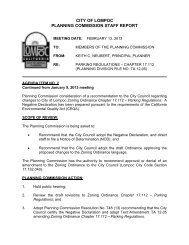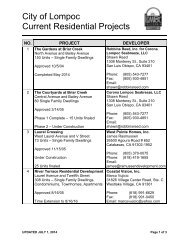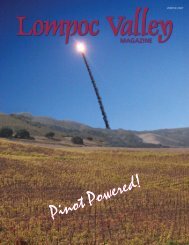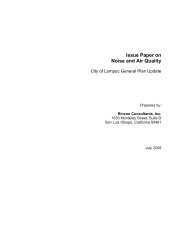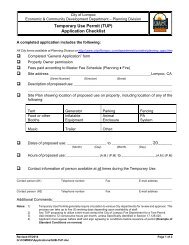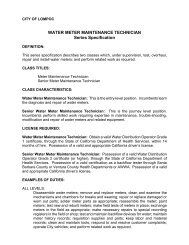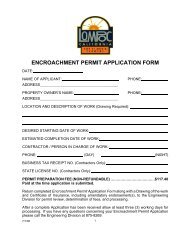Storm Water Pollution Prevention Plan (SWPPP) - the City of Lompoc!
Storm Water Pollution Prevention Plan (SWPPP) - the City of Lompoc!
Storm Water Pollution Prevention Plan (SWPPP) - the City of Lompoc!
Create successful ePaper yourself
Turn your PDF publications into a flip-book with our unique Google optimized e-Paper software.
proposed drainage swale. Run-on also occurs along <strong>the</strong> length <strong>of</strong> <strong>the</strong> transmission water main location,through sheet flow heading towards <strong>the</strong> Santa Ynez River. At <strong>the</strong> north end <strong>of</strong> <strong>the</strong> proposed transmissionwater main alignment, run-on occurs from a storm drain which terminates in a large, relatively steep gully,through which <strong>the</strong> transmission water main will be placed.The site is relatively flat to very gently sloping and drains by sheet flow. There is no run-on to <strong>the</strong> well site.Soils at <strong>the</strong> well site consist <strong>of</strong> layered sands that were moist to wet with a medium dense to denseconsistency. A isolated layer <strong>of</strong> silt soil exists at 14 -19 ft below <strong>the</strong> ground surface and <strong>the</strong> silt was moist andvery stiff. Groundwater was encoutered at a depth <strong>of</strong> 38 ft below <strong>the</strong> ground surface.The project is subject to requirements <strong>of</strong> <strong>the</strong> California Department <strong>of</strong> Fish and Game. The contractor shall beresponsible for ensuring compliance with all CDFG requirements and with <strong>the</strong> specific mitigation measures <strong>of</strong><strong>the</strong> project. The letter from <strong>the</strong> California Department <strong>of</strong> Fish and Game, <strong>the</strong> Notification <strong>of</strong> StreambedAlteration Agreement and its attachments are provided in Appendix J2.4 <strong>SWPPP</strong> ObjectivesThis <strong>SWPPP</strong> has been designed to address <strong>the</strong> following objectives:1. All pollutants and <strong>the</strong>ir sources, including sources <strong>of</strong> sediment associated with construction,construction site erosion and all o<strong>the</strong>r activities associated with construction activity are controlled;2. Where not o<strong>the</strong>rwise required to be under a Regional <strong>Water</strong> Board permit, all non-storm waterdischarges are identified and ei<strong>the</strong>r eliminated, controlled, or treated;3. Site BMPs are effective and result in <strong>the</strong> reduction or elimination <strong>of</strong> pollutants in storm waterdischarges and authorized non-storm water discharges from construction activity to <strong>the</strong> best availabletechnology economically achievable (BAT) / best conventional pollutant control technology (BCT)standard;4. Calculations and design details as well as Best Management Practices (BMPs) controls for site run-onare complete and correct, and5. Stabilization BMPs installed to reduce or eliminate pollutants after construction are completed.2.5 <strong>Storm</strong>water Run-on and Run<strong>of</strong>f from Offsite AreasRun-on is considered insignificant to <strong>the</strong> linear project and is received on site as sheet flow. The well site isapproximately 2 feet above existing grade and will not have any run–on. Run<strong>of</strong>f will also be minimal. The wellsite is less than 0.5 acre and run<strong>of</strong>f is directed to an existing roadside ditch. The disturbed area for <strong>the</strong>transmission water lines site is approximately 30 ft wide in unpaved areas and approximately 3’ wide in pavedareas. On unpaved areas, it is adjacent to stable vegetation and low gradients. On paved areas, water will beconveyed by <strong>the</strong> existing municipal storm drain system. There are no calculations.2.6 Risk AssessmentThe General Permit establishes three levels <strong>of</strong> risk possible for a construction site. Risk is calculated in twoparts: 1) Project Sediment Risk, and 2) Receiving <strong>Water</strong> Risk. The site's sediment risk and receiving water riskwas evaluated for <strong>the</strong> period <strong>of</strong> soil exposure (i.e. grading and site stabilization) using <strong>the</strong> methodology inAppendix 1 <strong>of</strong> <strong>the</strong> General Permit. This project is a combined traditional and linear project. The higher risklevel <strong>of</strong> Risk Level 2 (Type 2 LUP) was chosen to represent <strong>the</strong> entire site.Municipal <strong>Water</strong> Well No. 11Sediment Risk: MediumThe RUSLE equation was used through <strong>the</strong> Rainfall Erositivity Factor Calculator and <strong>the</strong> GIS Map Method todetermine soil risk. The online rainfall erosivity factor calculator (R) is based on soil erosivity and constructionscheduling. It was determined that <strong>the</strong> R factor is 24.62. Using <strong>the</strong> GIS Map Method and soil characteristicsdescribed in <strong>the</strong> Soils Engineering Report (2009), <strong>the</strong> project site lies in <strong>the</strong> KLS risk category <strong>of</strong> 1.0.Therefore, <strong>the</strong> project will contribute less than 75 tons/acre <strong>of</strong> sediment and has a medium sediment risk.Municipal <strong>Water</strong> Well No. 11 and Transmission <strong>Water</strong> Main – <strong>SWPPP</strong> July 20, 2010Page 7



